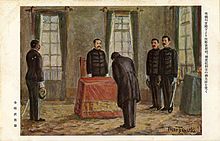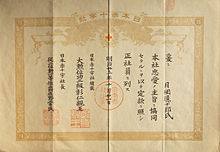Sano Tsunetami
Count Sano Tsunetami 佐野 常民 | |
|---|---|
Japanese Red Cross Society |




Biography
Sano was born in Hayatsue,
Nabeshima Naomasa had a strong interest in western technology and with the opening of the Nagasaki Naval Training Center in 1855. Sano was selected by the domain as one of its first students. The goal of Saga Domain was to build a western-style steam warship, which Sano helped complete in 1865.
Sano accompanied the Japanese delegation to the
After the
Sano also created the Ryuchikai, the forerunner of the Japan Art Association in 1879, in an attempt to stem the outflow of Japanese important cultural properties to overseas collectors.
From 1880-1881, he served in the Ministry of Finance, and in 1882 as president of the Genrōin. In 1886, he helped establish the first Red Cross Hospital in Japan.
In 1887, Sano was recognized for his accomplishments with elevation to the
In 1895, Sano was elevated to the title of count (hakushaku). On his death at his home in Tokyo in 1902, he was posthumously awarded with the Order of the Rising Sun (1st class with Paulownia Blossoms). His grave is at Aoyama Cemetery in Tokyo.
In 1939, the Japanese government issued a series of four
References
- Brunton, Richard. Building Japan 1868–1876. RoutledgeCurzon (1995). ISBN 1-873410-05-0
- Checkland, Olive. Japan and Britain after 1859: Creating Cultural Bridges. RoutledgeCurzon (2002). ISBN 0-7007-1747-1
- Cobbing, Andrew. The Japanese Discovery of Victorian Britain. RoutledgeCurzon (1989). ISBN 1-873410-81-6.
- Yoshikawa, Ryuko. Nisseki no soshisha Sano Tsunetami. Yoshikawa Kobunkan (2001). ISBN 4-642-05518-5(Japanese)
- Asahi, Keiko: Sano Tsunetami - kindai-Kokka no Paionia. In: W. Michel / Y. Torii / M.Kawashima (ed.): No rangaku Kyushu - ekkyō to Koryu. Kyoto: Shinbunkaku Shuppan, 2009 289–296 ( 朝日恵子「佐野常民- -越境と交流」思文閣出版 ). (Japanese)
